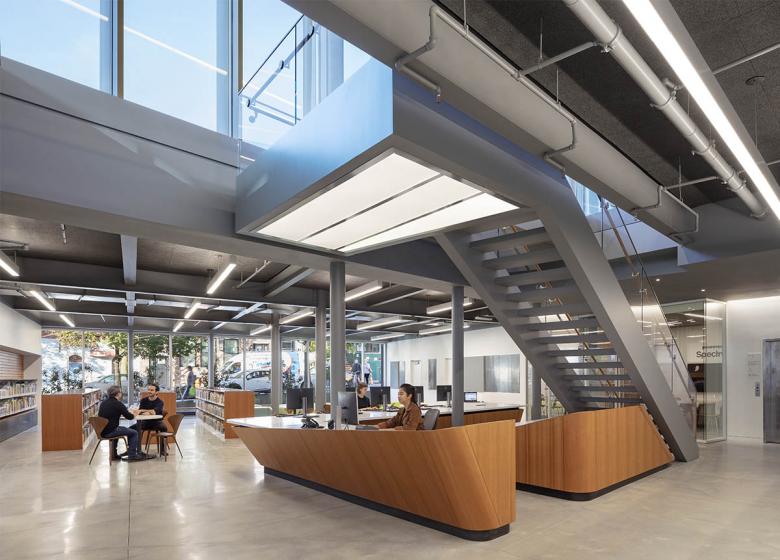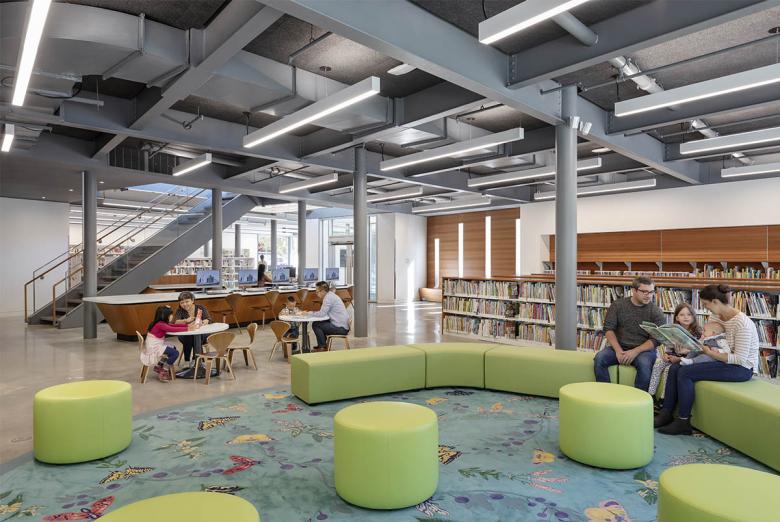US Building of the Week
Greenpoint Library and Environmental Education Center
Marble Fairbanks
21. 三月 2022
Photo © Michael Moran/OTTO
Located in a Brooklyn neighborhood scarred by years of industrial pollution, the Greenpoint Library and Environmental Education Center was designed as a demonstration project for innovative approaches to sustainable design. Marble Fairbanks answered a few questions about the project that is on target for LEED Platinum.
Location: Brooklyn, NY, USA
Client: Brooklyn Public Library
Architect: Marble Fairbanks
- Design Principals: Karen Fairbanks FAIA, Scott Marble FAIA
- Project Manager: Jason Roberts
- Project Team: Nicholas Desbiens, Peter Adams, Benjamin Hait, Keenan Korth, Lauren Espeseth, Spenser Krut, Tanya Gershon, Ravipa Ramyarupa, Atrianne Dolom
MEP/FP Engineer: ads Engineers, PC
Landscape Architect: SCAPE Landscape Architecture
Lighting Designer: Tillotson Design Associates
Contractor: Westerman Construction Co., Inc.
IT & Security: Cosentini Associates
AV Consultant: InToTo Professional Services, Inc.
Graphics and Wayfinding: MTWTF
Site Area: 11,875 sf
Building Area: 15,256 sf
See bottom for Important Manufacturers/Products.
Photo © Michael Moran/OTTO
What were the circumstances of receiving the commission for this project?The Greenpoint Library and Environmental Education Center is located in a community with a significant history of industrial development, toxic waste, and environmental activism. The first library on this site was a 1906 Carnegie library. After years of neglect, it was demolished and a new "Lindsay box" library was built on the site in 1973. Soon after the library opened, a 30-million-gallon oil spill was discovered in Newtown Creek, polluting over 100 acres of Greenpoint, compounding the impact of years of industrial pollution and leaks by neighboring factories. In 2010 Newtown Creek was designated a Superfund site, and in 2011 the Greenpoint Community Environmental Fund was created to manage a $19.5 million grant program. In 2014, the community voted to support this new branch library, focused on environmental education, with a $5 million grant. Brooklyn Public Library selected us through an RFP process in 2015.
Photo © Michael Moran/OTTO
Please provide an overview of the project.
The Greenpoint Library and Environmental Education Center is one of 58 neighborhood libraries that make up the Brooklyn Public Library (BPL) system. Distributed throughout the borough of Brooklyn, this network of libraries provides essential educational, cultural, and social services to the diverse communities they serve.
Funded in part from a Legacy Grant from the Greenpoint Community Environmental Fund, this project is the result of an active engagement between BPL and the community. The new building serves residents of all ages by partnering with local environmental groups to offer opportunities to learn about the rich history of Greenpoint and its specific ecological context. Many of those environmental groups are represented on the Community Advisory Committee, which acted as an integral participant in the design team’s inclusive design process.
The new building is a community hub for environmental awareness, activism, and education. The design doubles the size of the previous building, providing enlarged indoor and outdoor spaces to house expanded activities related to the exploration of the environment as well as everyday library use. The primary program elements are adult, young adult, and children reading rooms and collection spaces, and community spaces. Lab spaces for interactive projects, a large community event space (which can be divided into additional lab spaces), a lounge, small meeting rooms, and staff spaces are distributed throughout the two levels.
Photo © Michael Moran/OTTO
What are the main ideas and inspirations influencing the design of the building?We identified the priorities for the project through client and community-based workshops and regular meetings with the community advisory committee, ensuring that those most likely participate in and provide the activities will have a building that is flexible and useable. The building has visually connected, yet spatially distinct, areas for patrons. Children and adults have unique reading and collection spaces on the ground floor, connected by a centrally located stair to teens and open lounge space on the upper level. The teen space and community meeting spaces accommodate hands-on experimentation in a laboratory-like environment — with counters, sinks, and digital tools for all types of workshops — and direct connection to outdoor spaces. The large community event space is visible from the street and can be subdivided for a range of different activities. Flexible furniture and integrated digital technology support contemporary needs and provide the ability to adapt the spaces to change over time. Throughout the building, the building systems are revealed and important moments connect the building to larger environmental issues. The previous library was heavily used and overcrowded, so the new building provides much-needed additional for augmented programming to serve even more patrons.
Photo © Michael Moran/OTTO
With the ambition “to create environmental stewards and nature lovers out of future generations of New Yorkers,” moments highlighting environmental awareness are integrated throughout. The landscape supports a local natural ecosystem. Building systems, solar windows aligned with equinoxes and solstices, and local materials are noted in the interior. Exterior materials include custom sandblasted wood and cast concrete panels, developed with a local Brooklyn artisan. The expansive outdoor landscape assists in stormwater retention and the ongoing combined sewer overflow problems through bioswales at the street level. Water is also collected on an upper roof, stored in a visible cistern, and accessed by community members to water the raised community gardens. The landscape provides habitats for native birds and pollinators.
The Greenpoint community has minimal access to green space, so the massing of the building was designed to allow for extensive exterior space, including a new civic public space at the street. The landscape has three distinctive learning environments that all support the larger educational mission of the building. As we emerge from the strict pandemic practices at the height of COVID, we have seen how the extensive exterior spaces, and their direct connection to shared communal spaces inside, have allowed this library to pursue expansive public programming focusing on environmental activism and act as a community hub for education, and awareness, in the larger context of public responsibility.
Photo © Michael Moran/OTTO
How does the design respond to the unique qualities of the site?The project is located near significant industrial sites with limited outdoor green space. Industrial waste and oil spills contaminated over 50 acres in this community, and, during construction, we removed toxic soil from previous building fill on this site. This project assertively addresses the toxic history that has burdened this community by providing greatly expanded green spaces that support the ecological health of this place over time. There are three essential civic spaces, tiered from street level to upper planted green roofs, providing immersive landscapes for public activities and supporting local fauna and pollinators. The reimagined landscape includes the Glacial Streetscape featuring granite outcroppings formed from bands of stone skins recycled from New York State quarries and aligned with the NW to SE movement of the Laurentide Ice Sheet across Brooklyn during its expansion 18,000 years ago. Additionally, native forest plantings of grasses, groundcovers, and a planted bioswale along the street edge create an educational entrance to the library on this highly visible and active corner. The Reading Garden off the second floor includes wood benches for solitary reading or group activities at the edge of a mounded shrub thicket, formed of native and fruit-bearing plants providing valuable food and habitat for birds and insects. And on the third floor, the Demonstration Garden provides community planting space in raised beds, and a Pollinator Garden, planted with sedum beds, wraps the perimeter of the upper roof.
Photo © Michael Moran/OTTO
What products or materials have contributed to the success of the completed building?Material selection was critical in the development of the project including emphasizing building materials that use recycled content and that are regionally sourced. Over 87% of all wood comes from sustainably managed forests. Steel was chosen as the primary structural system to utilize recycled materials.
The exterior wood and concrete wall panels were developed and fabricated with a local craftsperson located ten minutes from the project site. Working iteratively with their shop, we developed a sand-blasted technique for finishing the cedar panels, removing a small amount of the soft wood in the grain pattern, accentuating the natural pattern on the façade. We then utilized those sand-blasted panels to cast the glass fiber reinforced concrete panels that are located on the lower level of the building. The wood will weather to begin to match the concrete in color, changing its appearance over time.
Meeting rooms throughout the library include woods of native tree species featuring Walnut, Ash, and Red Oak, and the rooms are named correspondingly. Service positions at the front desk and on the second level, custom millwork seating at the solar windows, and display cabinets utilize native cherry wood.
We also worked with a local Brooklyn artist to design the rug for the children’s area. Their design is based on environmental themes and includes plants and insects found in the local ecosystem of the building and the landscape.
Email interview conducted by John Hill.
Photo © Michael Moran/OTTO
Important Manufacturers / Products:- Custom sandblasted cedar panels: Evan Eisman Company
- Custom glass fiber reinforced panels: ConcreteWorks East
- Metal panels: Morin, Pac-Clad
- Rainscreen: Advanced Architectural Products
- Curtain wall: Kawneer
- Glass: Oldcastle













